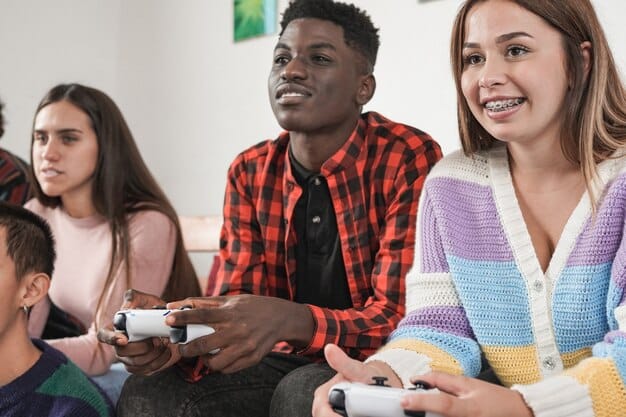Gamification in Education: Impact on Gen Z Motivation & Engagement

The integration of gamification in educational settings significantly enhances intrinsic motivation and engagement among Gen Z students by leveraging their inherent familiarity with digital interactions and by fostering environments that reward progress and offer immediate feedback, aligning educational objectives with their innate desire for challenge and achievement.
The landscape of education is continuously evolving, seeking innovative methods to captivate and empower students. A particularly compelling avenue garnering attention is the application of game-like elements to learning environments. But precisely, how does the use of gamification in education impact intrinsic motivation and engagement in Gen Z students?
Understanding Gen Z and Their Learning Preferences
Gen Z, broadly defined as individuals born between the mid-1990s and the early 2010s, represents a unique cohort shaped by an ever-present digital world. Unlike previous generations, they are true digital natives, having grown up with the internet, social media, and immersive digital experiences as an integral part of their daily lives. This upbringing has profoundly influenced their learning preferences and expectations, demanding approaches that resonate with their inherent comfort and proficiency in digital realms.
Their preference for visual communication, short-form content, and interactive experiences is notable. They often gravitate towards learning environments that offer immediate feedback, personalized pathways, and opportunities for collaborative engagement. Traditional didactic teaching methods can often fall flat, failing to capture their attention or stimulate their innate curiosity. Educators striving to connect with Gen Z must understand these fundamental shifts in learning styles and adapt their pedagogical strategies accordingly.
The Digital Natives’ Educational Blueprint
For Gen Z, learning is not merely about content acquisition but about an experience that is both meaningful and engaging. They thrive in environments that challenge them, allow for creative expression, and provide a sense of accomplishment. This generation is adept at multitasking and accustomed to rapid information processing, qualities that traditional educational models may struggle to accommodate. Their learning blueprint includes elements such as:
- Visual and Interactive Content: They prefer multimedia formats over lengthy text.
- Personalized Learning Paths: Tailored experiences that adapt to their pace and interests.
- Collaborative Opportunities: Working in teams, leveraging digital tools for group projects.
- Immediate Feedback: Quick responses to their efforts, allowing for rapid adjustments.
Moreover, Gen Z learners are highly independent, preferring to discover information themselves rather than being spoon-fed. They value authenticity and relevance, seeking connections between what they are learning and its real-world applications. This self-directed learning approach, coupled with their technological fluency, makes them ideal candidates for gamified educational experiences which leverage these very characteristics.
Understanding these preferences is the first critical step in harnessing the power of gamification. By designing educational experiences that mirror the engaging, feedback-driven, and interactive nature of the digital world they inhabit, educators can tap into Gen Z’s intrinsic motivations, making learning not just effective, but truly enjoyable and memorable.
Defining Gamification in the Educational Context
Gamification is distinct from game-based learning, though both involve games in education. While game-based learning uses entire games to teach concepts (like educational video games), gamification applies specific game design elements and game principles to non-game contexts, such as a traditional classroom or an online learning platform. The goal is to enhance engagement, motivation, and learning outcomes in a way that feels natural and compelling.
In education, this can involve incorporating points, badges, leaderboards, progress bars, levels, quests, or narrative structures into lessons, assignments, or even entire courses. The core idea is to transform routine educational tasks into challenges that evoke a sense of play, competition, or achievement. This transformation is not superficial; it redesigns the learning experience to tap into psychological drivers that make games inherently attractive.
Core Elements of Educational Gamification
The efficacy of gamification lies in its carefully selected elements, each designed to serve a specific purpose in motivating learners. These elements are not randomly chosen but are strategically integrated to align with educational objectives and student psychology. For Gen Z, who are accustomed to digital feedback and progress tracking, these elements resonate deeply.
- Points: Quantifiable recognition for achieving tasks, encouraging effort and tracking progress.
- Badges: Visual representations of accomplishments, symbolizing skills acquired or milestones reached.
- Leaderboards: Displaying progress relative to peers, fostering healthy competition and recognition.
- Levels: Representing mastery and progression through increasing complexity of content.
- Challenges/Quests: Structured tasks that guide learners through content, often with a narrative.
Beyond these tangible elements, gamification also relies on underlying psychological principles, such as the desire for mastery, autonomy, and relatedness. By providing clear goals, immediate feedback, and opportunities for choice, gamified systems empower students, giving them a sense of control over their learning journey. This autonomy is particularly appealing to Gen Z, who value self-direction and personalization in their digital interactions.

Furthermore, gamification encourages iterative learning through a forgiving environment where mistakes are opportunities for learning, akin to restarting a game level. This reduces the fear of failure and promotes persistent effort, crucial for complex subject matter. The strategic implementation of these elements creates a dynamic and responsive learning environment that fundamentally shifts the perception of education from a chore to an engaging challenge.
Impact on Intrinsic Motivation
One of the most profound impacts of gamification is its potential to foster intrinsic motivation. Intrinsic motivation refers to engaging in an activity for its inherent satisfaction rather than for some separable consequence. For Gen Z students, who often seek purpose and personalization, traditional extrinsic motivators like grades alone may not be sufficient to fuel deep, sustained engagement.
Gamification directly addresses intrinsic motivation by tapping into core psychological needs. It fosters a sense of autonomy by allowing choices in learning paths or challenges, competence by providing clear objectives and immediate feedback on progress, and relatedness through collaborative tasks or social recognition (e.g., leaderboards). When students feel a sense of mastery as they unlock new levels or earn badges, and a sense of belonging within a learning community, their internal drive to learn flourishes.
Autonomy, Competence, and Relatedness
Richard Ryan and Edward Deci’s Self-Determination Theory (SDT) posits that humans have three innate psychological needs: autonomy, competence, and relatedness. Gamified educational systems, when designed effectively, naturally address these needs. Students gain autonomy through choices in quests or tailored learning paths, fostering a sense of control over their education. Competence is nurtured through clear progression systems, instant feedback, and achievable challenges which affirm their growing skills and understanding.
Relatedness is often enhanced through collaborative gamified activities, team-based challenges, or even through visibility on leaderboards that connect them to their peers’ learning journeys. This intrinsic motivation is far more powerful than extrinsic rewards like grades alone, as it leads to deeper learning, greater persistence, and a more positive attitude towards education. Gamification shifts the focus from merely “doing well” to “mastering content” and “enjoying the process.”
For Gen Z, who value authenticity and personal growth, this emphasis on internal drivers is particularly salient. They are less likely to be motivated by rote memorization or compliance and more by challenges that stimulate their intellect and allow them to see tangible progression. The immediate and varied feedback inherent in gamified systems, whether through points, badges, or level-ups, provides the continuous affirmation that Gen Z is accustomed to in their digital lives, reinforcing their sense of accomplishment and fueling their desire to continue learning.
Enhancing Student Engagement Through Gamification
Engagement, especially with difficult or abstract concepts, is a perpetual challenge in education. For Gen Z, whose attention spans are often conditioned by the fast-paced nature of digital content, maintaining sustained engagement in traditional classroom settings can be particularly difficult. Gamification offers a compelling solution by making learning active, dynamic, and inherently more appealing.
By incorporating narrative elements, creating clear goals, and providing opportunities for repeated attempts without punitive consequences, gamification can transform passive learning into an active quest. This creates a flow state, where students are fully immersed and energized by the task at hand, forgetting distractions. The competitive aspect of leaderboards or collaborative challenges also plays a significant role, fostering a sense of camaraderie and healthy rivalry that compels students to participate more actively.
Strategies for Sustained Engagement
Effective gamification is more than just adding points; it’s about structuring the learning experience to be inherently captivating. Here are key strategies:
- Immediate Feedback Loops: Quick responses to actions, allowing for learning from mistakes.
- Progress Visualization: Clearly showing how far students have come and what’s next.
- Meaningful Challenges: Tasks that are difficult enough to be engaging but not overwhelmingly hard.
- Narrative and Storytelling: Weaving learning objectives into compelling storylines or quests.
Moreover, gamification can reduce anxiety associated with traditional assessments. By converting tests into “boss battles” or quizzes into “mini-games,” the pressure is reframed as a challenge to overcome, rather than a potential for failure. This shift in perception can lead to a more positive emotional experience of learning, encouraging Gen Z students to invest more effort and time.

The social component of many gamified systems allows for peer-to-peer learning and constructive competition, which is highly motivating for Gen Z. Collaborative quests or team-based leaderboards can encourage students to support each other, reinforcing learning through discussion and shared problem-solving. This interactive and social dimension breaks the monotony of solitary study, transforming education into a shared journey of discovery and achievement.
Challenges and Considerations in Implementation
While the benefits of gamification are clear, its successful implementation in educational settings is not without challenges. One primary concern is ensuring that the gamified elements genuinely enhance learning outcomes and do not merely serve as superficial add-ons. Poorly designed gamification can distract from the core curriculum, leading to frustration or a cynical view among students and educators.
Another significant hurdle is the potential for unequal access to technology or varying levels of digital literacy among students. For gamification to be truly inclusive, educators must consider the diverse technological environments of their students and provide necessary support. Furthermore, striking the right balance between competition and collaboration is crucial; excessive competition can demotivate some students, while little competition might not engage others effectively.
Avoiding Pitfalls and Ensuring Equity
- Overemphasis on Rewards: Don’t let extrinsic rewards overshadow intrinsic learning goals.
- Poor Design: Gamification must be well-thought-out, not just tacked on.
- Lack of Flexibility: Systems should allow for personalization and adaptation.
- Digital Divide: Ensure equitable access to resources and digital skills training.
Educators also need adequate training and resources to effectively design and manage gamified learning experiences. This includes understanding game design principles, leveraging appropriate technologies, and continuously assessing the impact of gamified elements on student learning and motivation. The initial setup and ongoing maintenance of gamified systems can be time-intensive, requiring commitment and support from educational institutions.
Moreover, it’s essential to integrate gamification thoughtfully into the existing curriculum rather than treating it as a separate entity. The game elements should reinforce learning objectives, not replace them. Regular feedback mechanisms from students are vital to refine the gamified approach, ensuring it remains relevant and engaging. By addressing these challenges proactively, educators can harness the full power of gamification to create truly transformative learning experiences for Gen Z students.
Future Trends and Best Practices
The future of gamification in education is bright, with ongoing advancements in technology and our understanding of learning psychology promising even more sophisticated and effective implementations. As AI and machine learning become more prevalent, gamified systems could offer unparalleled levels of personalization, adapting challenges and feedback in real-time to each student’s evolving needs and preferred learning style.
Augmented Reality (AR) and Virtual Reality (VR) also hold immense potential, creating immersive learning environments that were once unimaginable. Imagine history lessons conducted within a virtual ancient city, or biology classes dissecting 3D models with haptic feedback. These technologies could elevate engagement and intrinsic motivation to unprecedented levels, offering experiences that are not only educational but profoundly memorable.
Adopting an Adaptive and Holistic Approach
For educators and institutions looking to implement gamification effectively, several best practices are emerging. These go beyond simply adding leaderboards and badges, advocating for a more holistic and design-centric approach. Key among these are:
- Learner-Centered Design: Prioritizing student needs and preferences in gamified design.
- Clear Learning Objectives: Ensuring gamified elements directly support educational goals.
- Iterative Development: Continuously testing and refining gamified experiences based on feedback.
- Seamless Integration: Weaving gamification subtly into the existing curriculum rather than a separate layer.
Furthermore, emphasizing intrinsic over extrinsic rewards should remain a guiding principle. While points and badges can be initial motivators, the long-term goal is to cultivate a genuine love for learning. This requires designing systems that foster a sense of accomplishment, mastery, and autonomy, rather than merely incentivizing task completion. The focus should be on making the learning process itself rewarding.
The integration of social learning elements, such as collaborative quests and peer recognition, will continue to be crucial, given Gen Z’s affinity for social interaction within digital spaces. By blending cutting-edge technology with sound pedagogical principles, gamification can evolve into a powerful tool, not just for engaging students, but for cultivating lifelong learners capable of navigating an increasingly complex world.
| Key Point | Brief Description |
|---|---|
| 🎮 Engagement Boost | Gamification makes learning active and dynamic, capturing Gen Z’s digital native attention. |
| 💖 Intrinsic Motivation | It fosters autonomy, competence, and relatedness, leading to deeper, sustained learning. |
| 🧠 Gen Z Alignment | Aligns with Gen Z’s preference for visual, interactive, and feedback-driven experiences. |
| 🛠️ Implementation Hurdles | Challenges include design quality, equitable access, and teacher training for effective integration. |
Frequently Asked Questions About Gamification in Education
Gamification applies game elements (points, badges) to non-game contexts to enhance motivation for learning, while game-based learning uses complete games to teach specific concepts or skills. The former modifies existing teaching methods, whereas the latter integrates pre-designed educational games.
Gen Z, as digital natives, naturally connects with interactive, visual, and feedback-rich environments. Gamification aligns with their digital fluency by offering instant gratification, clear progress indicators, and opportunities for social interaction and competition, mirroring their common online experiences.
Yes, well-designed gamified systems often include multiple pathways and varied challenges, accommodating different learning styles. Some students might prefer competitive leaderboards, while others thrive in collaborative quests or self-paced progress, allowing for personalized learning experiences.
Potential drawbacks include the risk of over-reliance on extrinsic rewards, poor game design leading to distraction, equity issues if technology access is uneven, and the significant time and resources required for effective implementation and ongoing management by educators.
To foster intrinsic motivation, educators should focus on designing gamified experiences that promote mastery, autonomy, and relatedness. This means providing meaningful challenges, choices in learning, and opportunities for collaboration, ensuring rewards are secondary to the joy of learning and achievement.
Conclusion
The evidence overwhelmingly suggests that the strategic use of gamification in education profoundly impacts the intrinsic motivation and engagement of Gen Z students. By leveraging their innate digital fluency and preference for interactive, feedback-driven experiences, gamification transforms traditional learning into an active, enjoyable, and deeply personal journey. While challenges in implementation exist, a thoughtful, learner-centered approach that prioritizes intrinsic motivators over superficial rewards can unlock unprecedented levels of student involvement. As educational paradigms continue to shift, gamification stands as a powerful tool, not just for captivating a digitally native generation, but for fostering a lifelong love of learning that extends far beyond the classroom.





